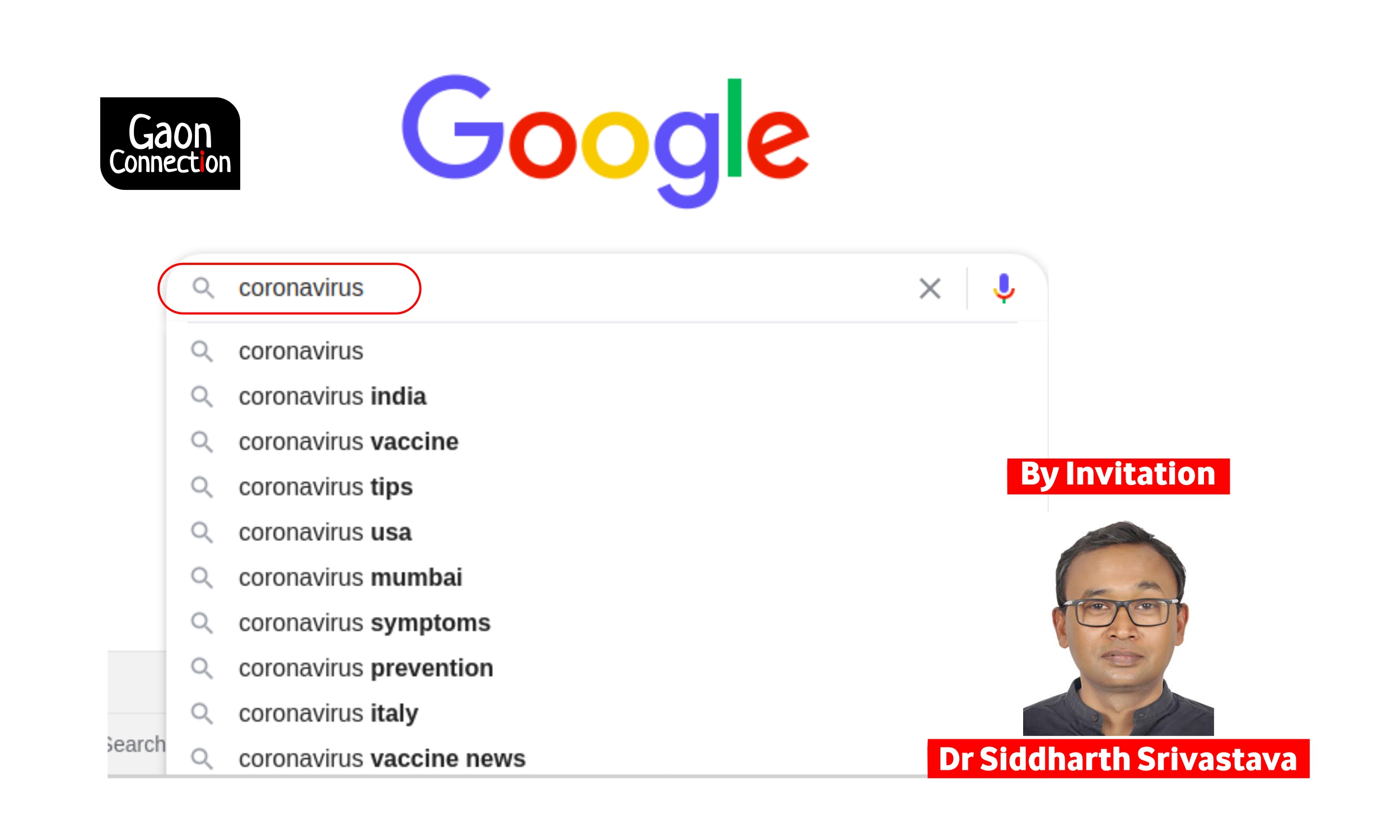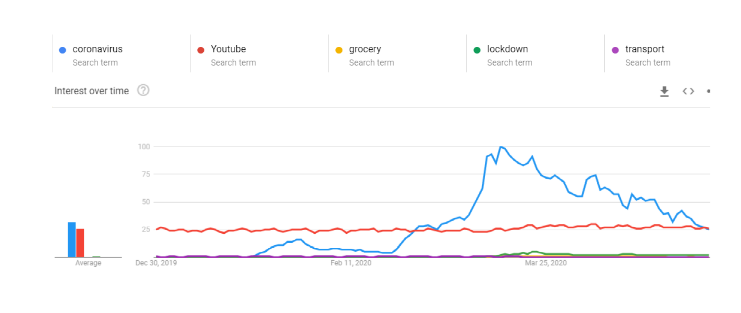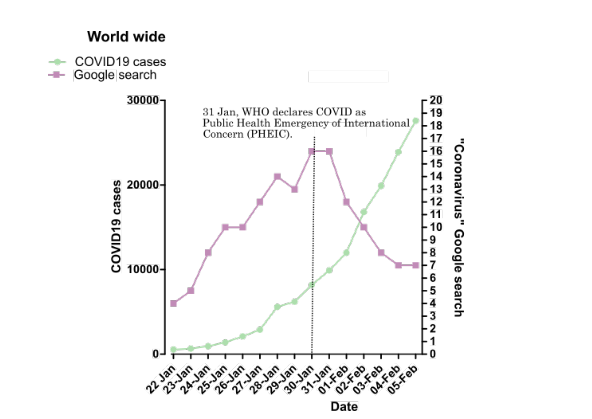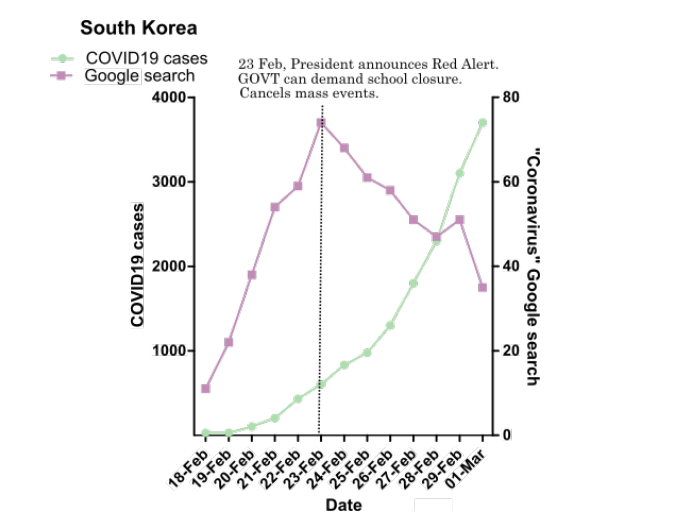It is interesting to know how people in India have perceived the COVID-19 threat. An analysis
It is not easy to know how people would react to the COVID-19 threat. An analysis of how and what people are searching on Google gives us an insight


The biology and psychology about how people react to known dangers are well studied, but what if the danger is something not encountered before? Young and old Indians today wouldn’t recall any threat which was even remotely like the COVID-19. It is interesting and important to know how people perceive such a threat. Policymakers make protocols and regulations keeping in mind both, what is in the best interest of the citizens and how citizens would react to the threat. Before halting air travel, interstate travel, enforcing lockdown, and even announcing a lockdown, policymakers need to predict how people will react.
However, it is not easy to find how people in such a large population would react to the COVID-19 threat. Here, the habit of people searching over the internet came to our rescue. In the digital age, Google is our “go-to” source for information. Hence an analysis of how and what people are searching on Google can give us a deep insight into how people react to a certain threat.
This is precisely what we did to find out how people reacted to the COVID-19 threat. We used Google tool, called “Google trends” which keeps a count of what people are searching and how many times. For our study, we selected five countries along with India, namely Germany, Italy, the US, and South Korea. The selection of these countries was primarily governed by the fact that they used different strategies to contain the COVID-19 spread with different degrees of success. The question was, how people perceived COVID-19 threat in these countries.
To begin with, we believed that COVID-19 posed an unknown threat which would induce anxiety in people. As a result of this people would Google search for various words such as “coronavirus symptoms”, “coronavirus treatment”, “coronavirus infection”, “pandemic” and “contagion”. Indeed, that was the case as shown in figure 1.

In fact, on January 31, 2020 when the World Health Organisation (WHO) announced that COVID-19 was a ‘public health emergency of international concern’, Google search of “coronavirus” showed a small, but significant, increase across the world (figure 2).

Between January and April 2020, Google search of “coronavirus” showed a large rise (figure 3). We compared Google search of “coronavirus” with other common but crucial words which were often used in this period such as “YouTube”, “lockdown”, “grocery” and “transport” (figure 3). It became clear to us that people searched “coronavirus manifolds compared to other terms mentioned here. The search term “YouTube” was significantly higher than “grocery”, “lockdown” and “transport”, but it did not rise significantly during the period coronavirus infection affected the population across the world.

This made us look deeper into each countries data individually. What we realised upon analysis was that people did not resort to google search “coronavirus” in response to rising numbers of COVID19 infected patients.
This made us look deeper into the data of each country separately. We started with the idea that the increasing numbers of COVID-19-infected patients would make people anxious and they would Google search “coronavirus” more. However, that was not the case. As shown in figure 4,

While the number of COVID-19-infected patients increased in Germany and South Korea, the Google search of “coronavirus” did not show a corresponding rise. The same was true with the data of India, the US, and Italy (Reference 1). Thus, the exponential rise of COVID-19-infected patients was not the trigger. Upon closer look, we found at specific time points the “coronavirus” Google search peaked in each of these five countries. These peaks conspicuously coincided with the announcement of “lockdown” in these countries. For instance, on February 23, 2020, South Korean president announced a red alert (lockdown equivalent) and closed all mass events and schools.
Similarly, in Germany, “coronavirus” Google searched peaked on March 22, 2020, when the Chancellor announced contact ban and every German was to maintain 5-6.5 feet distance from each other. In India, “coronavirus” Google search registered a sharp peak when Prime Minister Narendra Modi talked about the impending Janata Curfew on March 19, 2020 (Reference 1). Thus, it seems that people did not perceive the rising numbers of coronavirus-infected patients as a threat. However, a government announcement of a drastic measure such as lockdown or equivalent, made people aware of the magnitude of the threat and they tried to gather more information on coronavirus over the internet.
The day lockdown was announced in the five countries of interest, “coronavirus” Google search was significantly more than “grocery” and “transport”. This was puzzling as during a lockdown restricted availability of grocery and transport pose an immediate threat (figure 5). This could be because coronavirus posed a novel threat compared to restricted grocery and transport.

What should we conclude from this study?
Announcement of the lockdown (or equivalent) and not exponential rise in numbers of coronavirus infected individual acted as a trigger for people to Google search “coronavirus”. Thus, during a pandemic, the day a government announces lockdown or equivalent is also the ideal time to provide people with the best information and resources. Also, the governments can be transparent with the information on infection rates as it does not seem to trigger anxiety, which is evident from the “coronavirus” Google search pattern.
Methodology:
1. Google Trends (https://trends.google.com/trends/?geo=US) was used to analyse Google searches of terms “coronavirus”, “grocery”, “transport”, “YouTube” and “lockdown” in various countries listed here. Google search numbers represent search interest relative to the highest point on the chart for the given region and time. A value of 100 is the peak popularity for the term. A value of 50 means that the term is half as popular. A score of 0 means there was not enough data for this term.
2. Johns Hopkins coronavirus resource center (https://coronavirus.jhu.edu/map.html) was used to count confirmed coronavirus infected people on a given date, in countries studied here.
Reference:
1. https://sites.google.com/view/molecularpathology/home/covid19?authuser=0
Siddharth Srivastava is a chief scientist at the Neuberg Center for Genomic Medicine, Ahmedabad. Study and views are personal.

